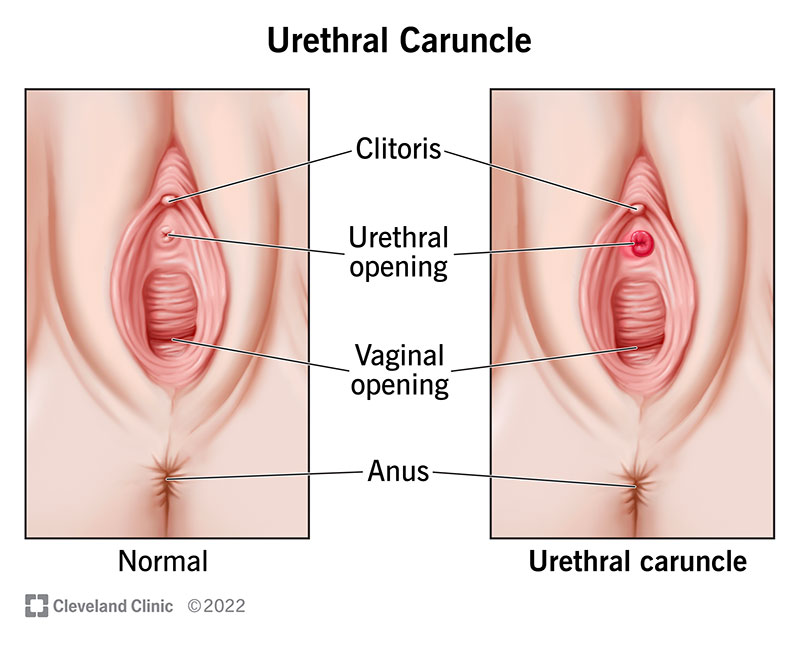A urethral caruncle is a noncancerous growth that forms on your urethral opening. There’s a link between this condition and low levels of estrogen, so it’s most common after menopause. You don’t need treatment unless it causes symptoms. But a proper diagnosis is important because urethral caruncles can resemble other, more serious lesions.
Advertisement
Cleveland Clinic is a non-profit academic medical center. Advertising on our site helps support our mission. We do not endorse non-Cleveland Clinic products or services. Policy

A urethral caruncle (pronounced “yu-REE-threl” “KAR-uhng-kuhl”) is a small, noncancerous (benign) growth. It grows on the outside of your urethra. It usually sticks out a little on one side. Urethral caruncles aren’t cancer and usually aren’t dangerous.
Advertisement
Cleveland Clinic is a non-profit academic medical center. Advertising on our site helps support our mission. We do not endorse non-Cleveland Clinic products or services. Policy
They happen most often in females who’ve been through menopause. They’re also the most common type of urethral lesion that affects females.
Most of the time, they don’t need treatment. But these growths sometimes look like other, more serious lesions. For this reason, it’s a good idea to talk with a healthcare provider. They can rule out other conditions, like cancer.
In most cases, urethral caruncles don’t cause any symptoms. Most people don’t even know they have one until a healthcare provider finds it during an exam. But sometimes, you may develop symptoms like:
Urethral caruncles usually measure 1 to 2 centimeters in diameter. That’s about the size of an aspirin tablet. They also tend to stick out on one edge. They’re usually red or pink. But they can turn black or purple if a blood clot forms.
A urethral caruncle looks similar to a urethral prolapse. But a urethral prolapse looks more like a tiny pink donut. That’s because the prolapse causes your urethra to stick out on all edges.
Medical experts aren’t certain what causes urethral caruncles. But you’re at a higher risk if you’ve gone through menopause. Experts believe low estrogen plays a role.
Advertisement
Estrogen keeps the skin in your genital area soft and flexible. When estrogen levels drop, you’re more likely to have dry, thin skin that tears easily. Experts think this is why urethral caruncles are more common after menopause.
Urethral caruncles are most common if you’ve been through menopause. They can also occur before menopause, though it’s not very common.
Urethral caruncles in males are extremely rare.
Most of the time, healthcare providers detect urethral caruncles during routine pelvic exams. Urethral caruncles may look like other types of urethral growths. These include certain types of cancer, like:
Providers often recommend removing some of the tissue for testing (biopsy). They’ll test the sample to rule out cancer or other conditions. They may also recommend a cystoscopy to look inside your urethra and urinary bladder.
You don’t need to treat a urethral caruncle unless it’s causing discomfort. Healthcare providers recommend treatment if it affects your quality of life.
The most common urethral caruncle treatments include:
Follow these steps to apply estrogen cream to a urethral caruncle:
Yes. In addition to using topical creams, you can take warm sitz baths. A sitz bath can soothe the area and help ease your symptoms.
Some people also apply petroleum jelly to the caruncle. Petroleum jelly acts as a barrier to help alleviate irritation.
It depends. You may start to see improvements within six weeks of using a topical estrogen cream. But it may take six months or longer for a urethral caruncle to completely go away. And if you stop treatment, it may grow back.
Call a healthcare provider right away if you have pain or bleeding around your urethra. You should also reach out if it burns or hurts when you pee.
If a healthcare provider thinks you have a urethral caruncle, you may want to ask:
Advertisement
Your healthcare provider may recommend tests if they think you have one. Tests help rule out more serious conditions, like cancer.
You don’t need treatment unless the growth causes pain or other problems. If it does, your provider will likely prescribe a cream or medications. If those treatments don’t work, you may need surgery.
No. A urethral polyp is a different type of urethral lesion. It most commonly affects females. Urethral caruncles typically develop after menopause. A urethral polyp is present at birth. Urethral polyps consist of tough tissue. They’re more likely to cause blood in your pee and a urinary blockage. Blockages cause a weak pee stream or completely stop you from being able to pee.
It can be stressful and scary to notice any changes in your body, especially in your more sensitive areas. And it can be easy for your mind to jump to worst-case scenarios when you see a growth. But a urethral caruncle isn’t usually a cause for concern, and treatment is often successful. Still, it’s important to see a healthcare provider as soon as you notice any changes. And if they cause symptoms, that’s your body’s way of telling you something is wrong. A provider can make an official diagnosis and recommend the best therapy for you.
Advertisement
From routine pelvic exams to high-risk pregnancies, Cleveland Clinic’s Ob/Gyns are here for you at any point in life.

Last reviewed on 09/08/2025.
Learn more about the Health Library and our editorial process.